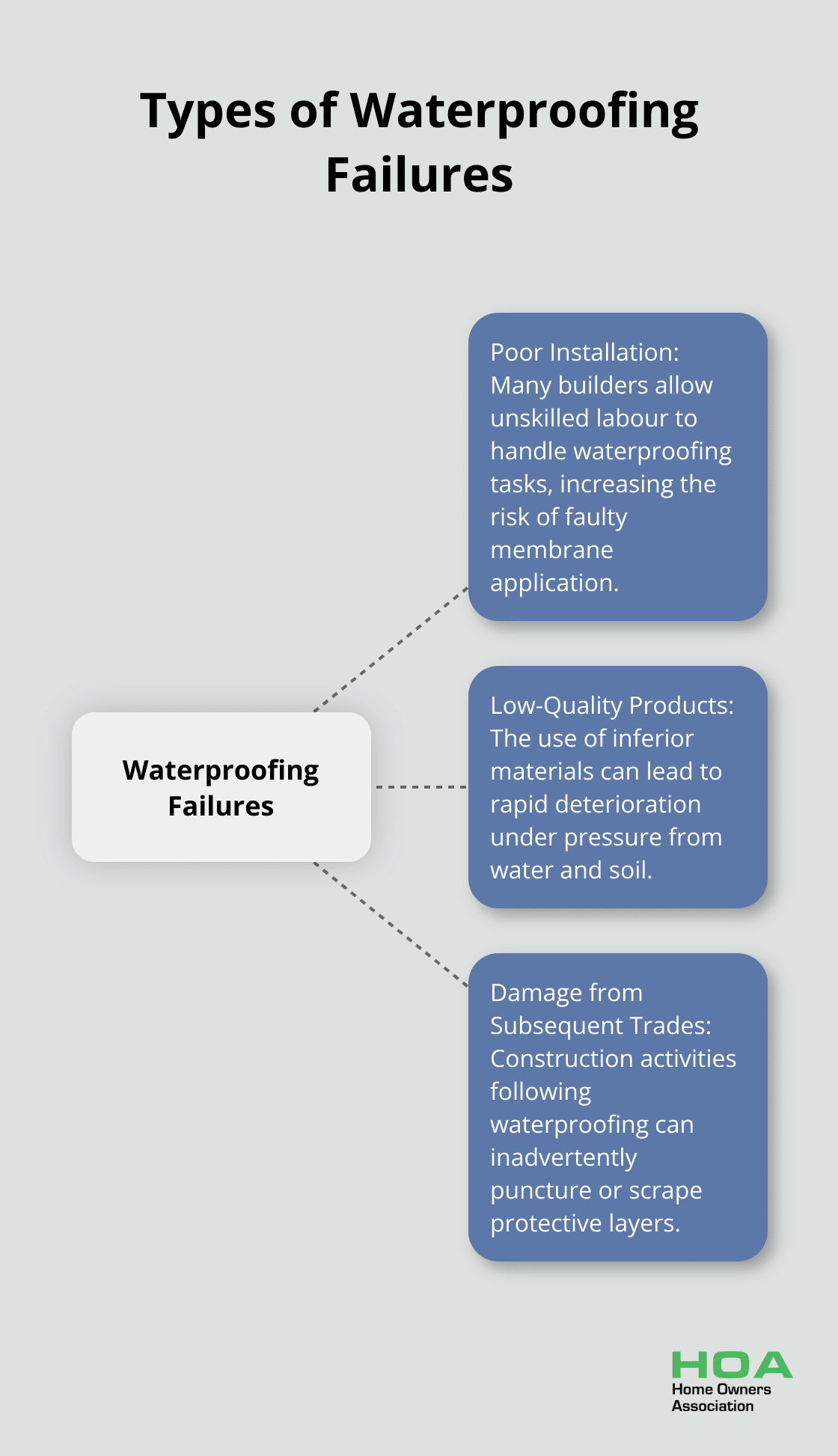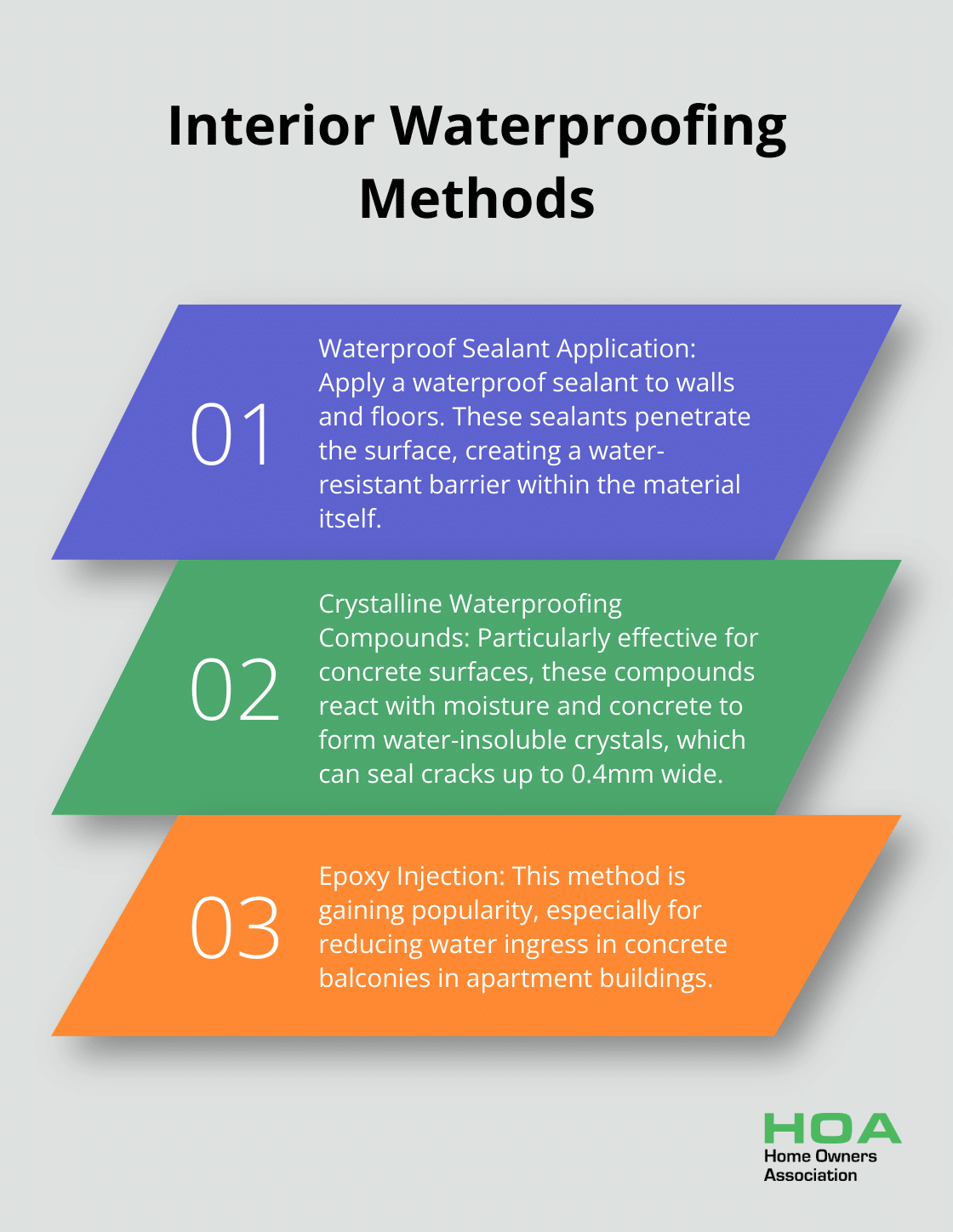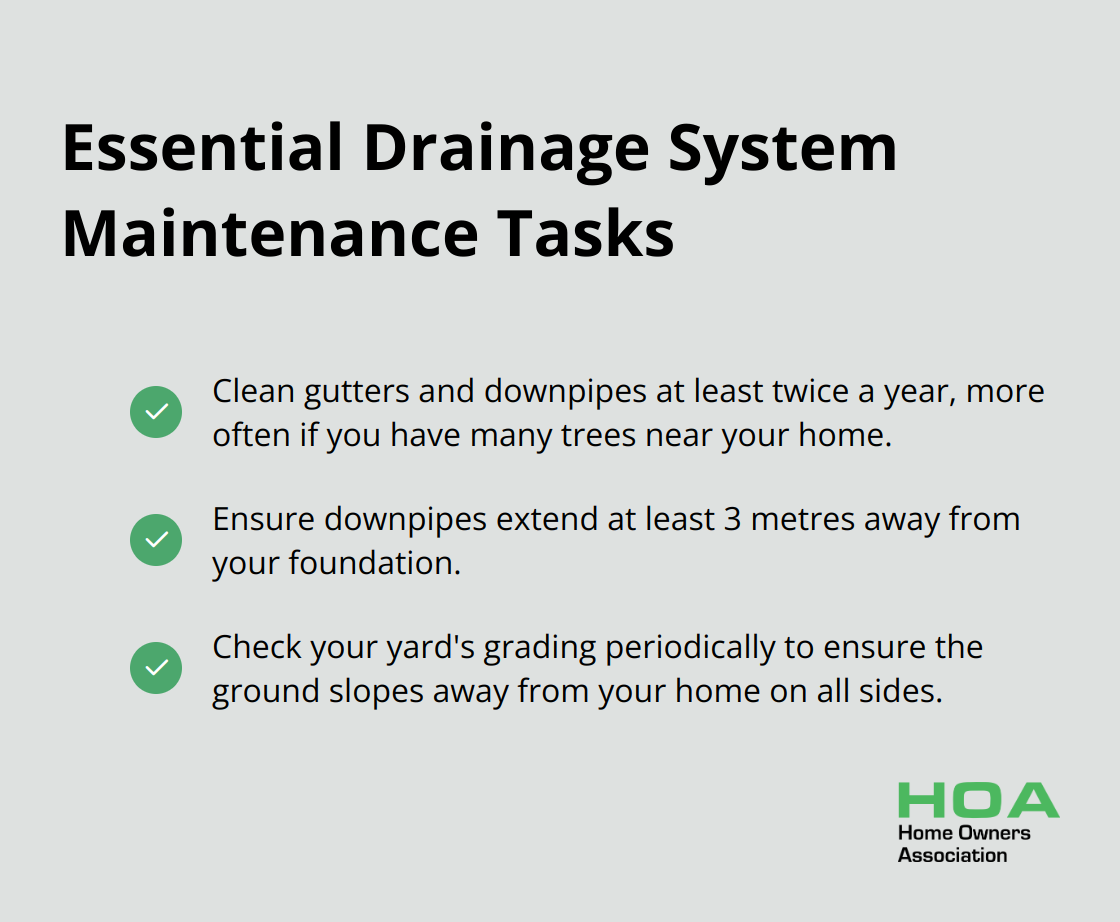
At Home Owners Association, we understand the importance of protecting your property from water damage. Negative waterproofing issues can lead to costly repairs and structural problems if left unchecked.
In this blog post, we’ll explore effective strategies to prevent water intrusion and maintain a dry, healthy home. From identifying early warning signs to implementing robust waterproofing techniques, we’ll provide you with practical tips to safeguard your investment.
Common Waterproofing Issues: Identifying and Understanding the Threats
Water damage poses a silent but significant threat to homes across Australia. The Australian Building Codes Board emphasizes the importance of moisture control in maintaining safe and durable home environments. This underscores the importance of understanding and addressing common waterproofing issues.
Early Warning Signs of Water Damage
Homeowners must remain vigilant for early indicators of water intrusion. These signs include:
- Damp spots on walls or ceilings
- Peeling paint
- Musty odours in basements or crawl spaces
Prompt identification of these symptoms can prevent minor issues from escalating into major problems.
Types of Waterproofing Failures
Waterproofing can fail due to various factors:

- Poor Installation: Many builders allow unskilled labour to handle waterproofing tasks, increasing the risk of faulty membrane application.
- Low-Quality Products: The use of inferior materials can lead to rapid deterioration under pressure from water and soil.
- Damage from Subsequent Trades: Construction activities following waterproofing can inadvertently puncture or scrape protective layers. (This highlights the need for better inter-trade communication.)
Structural Consequences of Inadequate Waterproofing
The impact of poor waterproofing on a home’s structure can be severe:
- Concrete Spalling: Water infiltration causes reinforcing steel within concrete structures to corrode and expand, leading to cracking and flaking of the surrounding concrete.
- Wood Rot and Mould Growth: Persistent moisture creates an ideal environment for decay in wooden structures, compromising the strength of support beams and joists. (This also poses serious health risks to occupants.)
- Foundation Damage: Hydrostatic pressure from saturated soil forces water through tiny cracks, potentially destabilising the entire foundation.
Financial Implications of Waterproofing Issues
The costs associated with water damage can be staggering. What starts as a small leak can quickly escalate into significant repairs.
The Australian Building Codes Board emphasizes the importance of moisture control in maintaining safe and durable home environments. Home Owners Association supports this stance, offering members access to expert advice and resources to ensure all projects meet the highest quality standards.
As we move forward, we’ll explore effective waterproofing techniques that can help protect your home from these common issues and preserve its structural integrity for years to come.
Mastering Waterproofing Techniques: A Comprehensive Approach
At Home Owners Association, we’ve witnessed the devastating effects of water damage on homes across Australia. We’re committed to helping homeowners implement effective waterproofing strategies. Let’s explore proven techniques that can significantly reduce the risk of water intrusion and protect your property.
Exterior Waterproofing: Your First Line of Defence
Exterior waterproofing prevents water from penetrating your home’s structure. One of the most effective methods involves the application of a waterproof membrane to the exterior walls of your foundation. This membrane acts as a barrier, blocking water from seeping through even the tiniest cracks.
For optimal results, we recommend using a high-quality elastomeric membrane. These membranes can help monitor water quality and show close correlation with water chemistry from control areas.
Your roof plays a critical role in your home’s waterproofing system. Regular inspections and maintenance prevent leaks before they start. Apply a waterproof coating to your roof every 5-7 years to enhance its water-resistant properties.
Interior Waterproofing: A Vital Second Layer
While exterior waterproofing is ideal, it’s not always possible or sufficient on its own. Interior waterproofing provides an additional layer of protection, especially in basements and areas prone to moisture.

One effective interior waterproofing method involves the application of a waterproof sealant to your walls and floors. These sealants penetrate the surface, creating a water-resistant barrier within the material itself. For concrete surfaces, crystalline waterproofing compounds prove particularly effective. These compounds react with moisture and concrete to form water-insoluble crystals, which can seal cracks up to 0.4mm wide.
Another interior waterproofing technique gaining popularity is the use of epoxy injection. This method can help reduce water ingress in concrete balconies in apartment buildings.
The Critical Role of Proper Drainage
Even the best waterproofing systems can fail if water accumulates around your home. Proper drainage is an essential component of any comprehensive waterproofing strategy.
Start by ensuring your gutters and downpipes are clean and functioning correctly. Downpipes should direct water at least 3 metres away from your home’s foundation. Consider installing a French drain system around your property to channel water away from your home’s foundation. These systems can be particularly effective in areas with heavy rainfall or poor natural drainage.
For basements, a sump pump is an essential tool in preventing water accumulation. Make sure your sump pump is properly sized for your home and test it regularly to ensure it’s working correctly.
Professional Waterproofing Services: Expertise Matters
While some waterproofing tasks can be DIY projects, complex issues often require professional intervention. Professional waterproofing services offer several advantages:
- Expertise in identifying underlying issues
- Access to high-quality, commercial-grade materials
- Knowledge of local building codes and regulations
- Warranty on workmanship (which can provide peace of mind for homeowners)
When selecting a waterproofing service, look for licensed and insured professionals with a track record of success in your area. (Home Owners Association members can access our vetted list of trusted waterproofing professionals across Australia.)
The next chapter will explore essential maintenance and prevention strategies to keep your waterproofing systems in top condition for years to come.
Proactive Maintenance Strategies for Lasting Protection
Regular Inspections: Your First Line of Defence
Start by visually inspecting your home’s exterior, looking for signs of water damage or deterioration, such as peeling paint, cracks in the foundation, or other issues. Focus on areas prone to moisture, such as basements, crawl spaces, and around windows and doors. Don’t overlook your roof; check for missing or damaged shingles that could lead to leaks.
Prompt Action on Minor Issues
Small problems can quickly escalate if ignored. A tiny crack in your foundation might seem insignificant, but it can allow water to seep in and cause extensive damage over time. The same applies to small leaks in your plumbing or roof. When you spot a potential issue, take immediate action. For minor cracks, apply a high-quality sealant designed for your specific surface type. If you’re unsure about the severity of a problem or how to address it, consult a professional.
Drainage System Maintenance
Your home’s drainage system plays a vital role in directing water away from your foundation. Clean your gutters and downpipes at least twice a year (more often if you have many trees near your home). Ensure downpipes extend at least 3 metres away from your foundation. Check your yard’s grading periodically. The ground should slope away from your home on all sides. If you notice areas where water pools near your foundation after rain, add soil to improve the grade or install a French drain system.

Sump Pump Care
For homes with sump pumps, test the pump every few months to ensure proper function. Install a battery backup system to keep your pump running during power outages.
Professional Waterproofing Services
While some maintenance tasks can be DIY projects, complex issues often require professional intervention. Professional waterproofing services offer several advantages:
- Expertise in identifying underlying issues
- Access to high-quality, commercial-grade materials
- Knowledge of local building codes and regulations
- Warranty on workmanship
When selecting a waterproofing service, look for licensed and insured professionals with a track record of success in your area.
Final Thoughts
Protecting your home from water damage requires effective waterproofing strategies and constant vigilance. Regular inspections, immediate attention to minor issues, and proper maintenance of drainage systems prevent negative waterproofing problems. A well-protected home maintains its structural integrity, preserves its value, and provides a healthier living environment for your family.
Proactive home maintenance forms the foundation of effective waterproofing. Small efforts you make today in maintaining your home’s waterproofing systems lead to significant savings and peace of mind in the future. You can avoid costly repairs and the stress associated with major renovations by addressing potential water issues proactively.
At Home Owners Association, we help Melbourne homeowners protect their investments. Our members receive expert advice, access to quality resources, and savings on materials for construction, renovation, and maintenance projects (including negative waterproofing solutions). Take action today to safeguard your home against water damage and enjoy the security of a well-protected living space.





